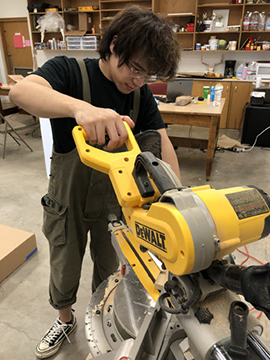By DEVYN LANSDEN, Student Reporter
Chang Wu is the November artist in residence at Northwestern Oklahoma State University.

Chang was born in Wenzhou, China, in 1992 and attended college at the China Academy of Art. Chang said there’s no difference between a designer and an artist because the fundamentals are the same. He said he was taught the same skills while learning design.
Chang found out about this residency because he met Kyle Larson, Northwestern’s art professor, when Larson visited Boston University and Chang invited him to look at his work.
When Chang came to America, he had a hard time communicating and comprehending English, he said. He misunderstood a lot of things, and he realized the same shape of things in a different culture has different meanings and the same goes with language, he said. He said it was hard to learn the different meanings and different contexts of words.
Chang said when he speaks English and when he speaks Chinese, he has a different way of thinking. This inspired him because this caused him to ask himself how tools can affect our bodies.
Chang decided to abandon his design career and put all of his effort on the art territory. He did one assignment from his design company, and as a designer, you have to listen to people’s opinions and change your design to the way your client wants, he said.
He had to do his assignment 14 times because of all the feedback he got on each assignment. At the end, the company decided to use his first version. Chang said he couldn’t be himself working for people.
Chang said the two most challenging parts of being an artist are making enough money to support himself and the mental stress that comes with the work. He said it is easy to question yourself and be influenced by other people.
“You have to be very confident about what you’re doing,” Chang said.
Chang says his art work is open to how other people approach his work. He doesn’t put any descriptions with his work on purpose so people can think what they want about it.
He said he can’t manipulate how people see his work.
Chang said his favorite work looks simple but, he put a lot of effort into it. He spent almost two months making different versions of it. At the end, it was so simple but has a complex effect.
He used an HDMI cable that was connected to a camera and a projector that pointed to the camera. It created a time loop because the camera was catching the light from the projector and the projector was projecting a picture.
He said it was very powerful but simple.
